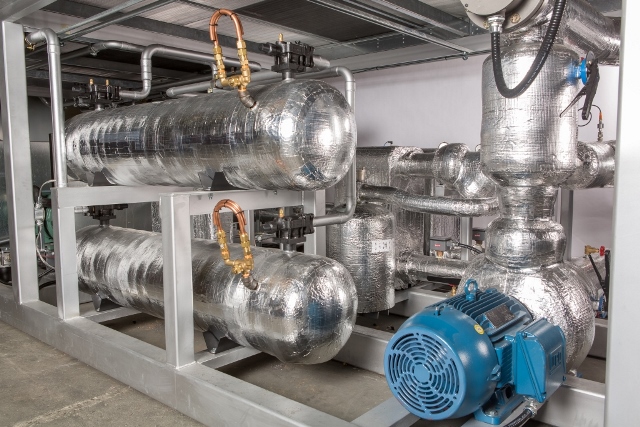Coolant is a medium used to absorb or transfer heat and maintain system temperature stability, widely applied in industrial cooling, automotive radiators, air conditioning refrigeration, and electronic device cooling.
In fluid cooling systems, the viscosity and density of the coolant are key parameters reflecting its physical state, purity, and system operational efficiency. Real-time monitoring of these parameters is crucial for maintaining optimal performance and longevity of high-density processors and critical components.
Types of Common Industrial Coolant
Common coolant is categorized into water-based coolant, organic coolant, low-temperature coolant and the like based on their functions and chemical components. Glycol is a kind of organic coolant commonly used in cooling systems, which combine glycols with water and additives like corrosion inhibitors, are widely used due to their excellent heat transfer and freeze protection properties.
However, maintaining coolant performance requires vigilant monitoring of viscosity, concentration, and degradation. In general, coolant degrades with concentration shifts and deposit formation while compromise system reliability.

Glycol-based Cooling Systems
Glycol-based cooling systems are the backbone of thermal management in data centers, industrial processes, and HVAC systems. These systems typically use propylene or ethylene glycol mixed with water to achieve a balance of heat transfer efficiency, freeze protection, and corrosion resistance. Additives, such as corrosion and degradation inhibitors, are included to protect piping and electronic components from damage. The performance of these systems hinges on maintaining optimal glycol concentration and detecting degradation early to prevent issues like corrosion, reduced heat transfer, or coolant deposits.
Key Properties to Monitor
- Glycol Concentration: Determines the coolant’s ability to transfer heat and protect against freezing and corrosion. Too high a concentration reduces heat transfer efficiency, while too low increases the risk of freezing or corrosion.
- Viscosity: A critical indicator of glycol concentration, as viscosity varies significantly with the glycol-water ratio and temperature.
- Degradation: Over time, glycols can break down into acidic compounds, leading to corrosion or the formation of deposits such as biofilms or corrosion products.
- Coolant Deposits: Contaminants, biofilms, or corrosion byproducts can accumulate in the system, reducing flow efficiency and accelerating component wear.
Challenges in Density and Viscosity MonitoringofGlycol-based Cooling Systems
Maintaining the reliability of glycol-based cooling systems is fraught with challenges, particularly in high-stakes environments like data centers where downtime is costly. Below are the primary hurdles:
- Concentration Fluctuations: Changes in glycol concentration can occur due to water evaporation, leaks, or improper maintenance. These shifts disrupt the balance between heat transfer and freeze/corrosion protection, potentially leading to system inefficiencies or failures.
- Coolant Degradation Over Time: Absolutely. Glycol-based coolants can degrade due to thermal stress, oxidation, or microbial activity, producing acidic byproducts that corrode metal components and form deposits. This degradation is often gradual and difficult to detect without continuous monitoring.
- Deposit Formation: Coolant deposits from corrosion products, biofilms, or contaminants can clog pipes and then reduce flow rates and heat transfer. These deposits are particularly problematic in data centers, where precision cooling is critical.
- Inconsistent Monitoring: Traditional monitoring methods, such as periodic lab analysis, are labor-intensive and provide delayed results, making it challenging to address issues in real-time. Electrochemical sensors (e.g., pH or conductivity) often require frequent recalibration and are susceptible to degradation themselves.
- Temperature Variability: Coolant viscosity is highly temperature-dependent, complicating concentration measurements without accurate temperature compensation.
- Integration Complexity: Integrating monitoring solutions into existing systems can be challenging, especially when dealing with diverse industrial protocols or legacy infrastructure.
These challenges underscore the need for robust, real-time monitoring solutions like inline coolant viscometers to ensure system reliability and longevity.
LonnmeterInlineViscometers— A Game-Changing Solution
Lonnmeter, a leader in industrial sensor technology, offers the inline viscometer, a robust and compact solution designed specifically for coolant viscosity monitoring in glycol-based cooling systems. The sensor stands out for its ability to monitor viscosity, temperature, and coolant deposits, providing a comprehensive picture of coolant health.
Key Features of the Lonnmeter
High-Precision Viscosity Measurement:
- Lonnmeter viscometers feature wide viscosity range from 1 – 1,000,000 cP with ±3% accuracy and ±1% repeatability. Customers are allowed to customize pressure range above 10 MPa if needed.
- Built-in temperature compensation ensures accurate measurements despite temperature fluctuations, a critical feature for data center environments.
Long-Term Stability:
- With a factory calibration that remains valid for over 15 years, the inline process viscometer eliminates the need for recalibration, unlike electrochemical sensors that require frequent maintenance.
Continuous Monitoring:
- Unlike lab analysis, which provides delayed results, the inline process viscometer offers real-time data, enabling proactive maintenance and reducing downtime.
Integration Flexibility:
- The inline process viscometer supports multiple industrial protocols (e.g., 4-20 mA, Modbus, HART), ensuring seamless integration into existing control systems.
- Lonnmeter’s Integration Team provides support for communication settings and remote configuration.
- In addition to all above features, ODM services are available to all customers in the event that standard automation sensors fall to meet your individual demands.
- Real-Time Insights: The inline process viscometer’s continuous measurements eliminate the delays associated with lab analysis.
- Maintenance-Free Operation: Simple mechanical structure ensures long-term lifespan and reduce maintenance costs.
- Integratable with PLC/DCSsystem: Adjust process lines based on historic data acquisition and analysis.
- Comprehensive Monitoring: Provide viscosity and temperature readings at the same time.
- Cost Efficiency: Reduced maintenance and downtime translate to significant cost savings for data center operators.
Advantages Over Traditional Methods
Effective monitoring of viscosity, concentration, and degradation in fluid cooling systems is essential for the reliability of data centers and other critical applications. Lonnmeter inline coolant viscometer addresses the challenges in glycol-based cooling systems by delivering real-time, high-precision measurements of viscosity, temperature, and coolant deposits. Contact engineers for more professional suggestions.
Media Contact
Company Name: SHENZHEN LONNMETER GROUP
Email: Send Email
Country: China
Website: https://www.lonnmeter.com/
